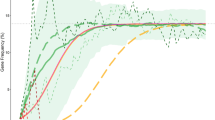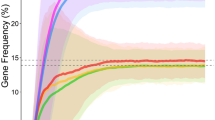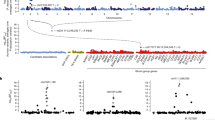Abstract
IT is now recognized that the sickle-cell trait, though inherited through a single gene, does not necessarily maintain a constant frequency in a population from, generation to generation, but that its frequency is the result of two opposing processes of natural selection. The gene for sickle-cell hæmoglobin (or hæmoglobin S) tends to be eliminated from the population because of the deaths of homozygotes from sickle-cell anæmia, while, in the presence of endemic falciparum (malignant tertian) malaria, homozygotes for normal adult hæmoglobin (hæmoglobin A) have a higher mortality than heterozygotes with genes for both A and S. The sickle-cell gene is thus maintained from generation to generation from the pool represented by the favoured heterozygotes. So long as malarial incidence remains constant, a state of balanced polymorphism will eventually be reached; but if the former then changes, there will be a gradual shift towards a new balance of genes. There can, therefore, be no doubt that the frequency of the sickle-cell trait in a population is, at least in part, related to the recent malarial history of that population.
This is a preview of subscription content, access via your institution
Access options
Subscribe to this journal
Receive 51 print issues and online access
$199.00 per year
only $3.90 per issue
Buy this article
- Purchase on SpringerLink
- Instant access to full article PDF
Prices may be subject to local taxes which are calculated during checkout
Similar content being viewed by others
References
Daggy, R. H., Amer. J. Trop. Med., 8, 286 (1960).
Lehmann, H., Eug. Rev., 46, 3 (1954).
Coon, C. S., The Races of Europe, 425 (New York, 1948).
Lehmann, H., Sharih, A., and Robinson, G. L., Man, 61, 108 (1961).
Author information
Authors and Affiliations
Rights and permissions
About this article
Cite this article
LEHMANN, H., MARANJIAN, G. & MOURANT, A. Distribution of Sickle-cell Hæmoglobin in Saudi Arabia. Nature 198, 492–493 (1963). https://doi.org/10.1038/198492b0
Issue date:
DOI: https://doi.org/10.1038/198492b0
This article is cited by
-
Use of a tourniquet in patients with sickle-cell disease
Canadian Journal of Anaesthesia (1993)
-
On the nature of sickle-cell disease in the Arabian Peninsula
Human Genetics (1979)
-
Association of duffy blood groups with the suckle cell trait
Human Genetics (1976)
-
Haemoglobin O Arab in Sudanese
Nature (1966)



